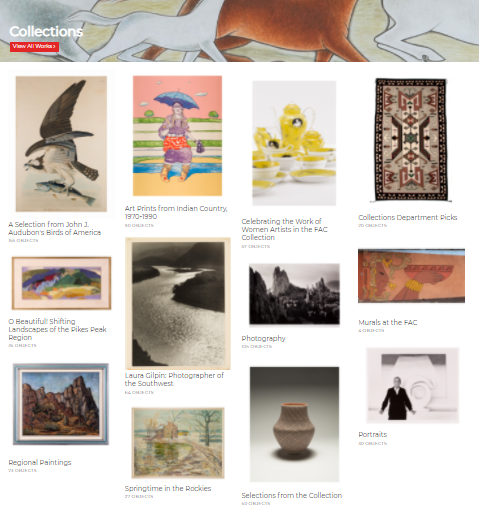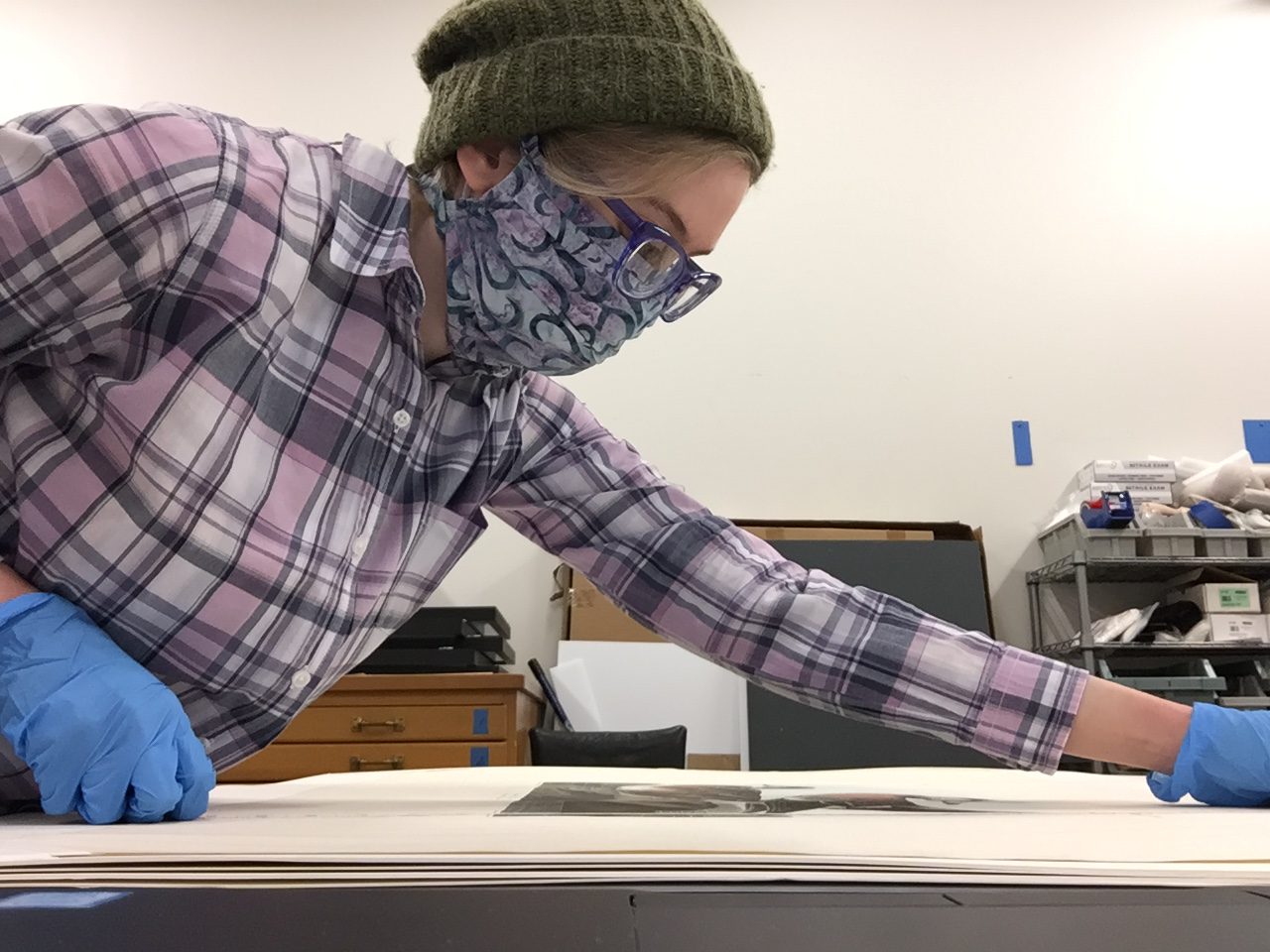By Gabrielle Friesen, Digital Collections Assistant
Hello everyone! I’m Gabrielle, and I was hired late last year as the Digital Collections Assistant for the museum at the Colorado Springs Fine Arts Center at Colorado College. I’m working on building our eMuseum — allowing digital access to the artwork in our collections. This work is being done under a grant from the Institute of Museum and Library Services, and the goal is to have 3,000 pieces from the Fine Arts Center’s collections available for digital viewing at the end of the project. If you’ve ever wondered about what goes on in the collections of the museum, here’s a look at what I’m working on as I get our digital collections up and running.

First, I pick a category of artwork to photograph. I do this with the help of the curatorial team and head of collections, as well as feedback from a 2019 community survey about what artwork categories you would like to see included on the Fine Arts Center’s eMuseum. Right now, I’m working on jewelry from the southwest. Art of the southwest was one of the highest requested categories from the community survey, and jewelry is only one small part of our collection of Southwestern artworks.
After the next art group is selected, I do a survey of the artwork in the storage area in preparation for photography. This survey includes measuring the artworks to verify and supplement the data provided by existing catalogue records (such as measurements and weight). This helps me plan how big the photography setup needs to be. For example, photographing small jewelry pieces is quite different than photographing large-scale prints or paintings. This survey period is also a good time for me to do a quick check-up on the artwork, to make sure everything is in good condition.
Some artwork had a life before it came to the museum, such as religious pieces like santos or altar pieces, which may have become worn through use and have existing damage. Heavy beadwork on a single string of a necklace can cause strain over time, even at rest, causing strings to fray or snap. While the museum has a tight pest control plan, sometimes bugs still get into the collections, where they can pose a risk to artwork made from wood, fibers, or other organic material that could be snacked on. (This is part of the reason no food is allowed in the galleries — crumbs and spills lure in bugs who then look for something else to eat). The initial survey lets me look at each object and keep an eye out for signs of bugs, broken pieces, or potential problem spots. If I find anything worrisome or out of the ordinary, I flag it for the registrar, so we can decide how best to support the object, and if outside treatment like repairs from a conservator are needed.
After I’ve surveyed the collections and decided which pieces can be moved and photographed safely and which pieces need to be reviewed for treatment instead, I move on to the photography. I help the photographer stage the artwork, ensuring it’s safely moved and handled. In preparation for publishing the photos on eMuseum, I check color profiles in Photoshop to ensure the colors will display correctly on screens. I also go into the museum’s database and update the measurement information. This information is helpful for both the public and the museum to have. A small phone screen might hide how big a piece of art actually is, but the measurements still give some clue — letting you know if the piece is 5″ by 5″ or 45″ by 45″. On the museum side, the measurements are helpful to know for exhibits purposes, so the exhibit and curatorial team know how big a piece is while planning out an exhibition. This helps them make decisions about how many pieces can be displayed and where an art piece can be put in the galleries.

Here I am measuring an Audubon print of widgeons. I always wear nitrile gloves when working with collection pieces, because the oil our hands naturally produce can be harmful to the artwork.
Before I publish a package of artwork to the eMuseum, the curatorial team steps in to double-check that information like title and artist is correct, and that in some point in the museum’s 85-year history, the name wasn’t accidentally misspelled, or the titles of two pieces accidentally swapped. The FAC wants to have as much information as possible on each piece of art, so this is an important step to ensure the information is not only present but also correct.
Finally, when the artwork has been safely photographed and all information checked and updated, I publish it to eMuseum so that you all can view our collections from anywhere. This accessibility was especially important in the past year, during the period when the museum was closed, and during our capacity-limited operations. Digital collections allow everyone to view the museum’s collections, even if they can’t access the museum. This is important outside of the pandemic as well — we want as many people as possible to be able to see our collections, whether they’re on the other side of the globe from the Fine Arts Center, or just down the block. The eMuseum is a good resource for educators, both K–12 and within Colorado College itself to use with students in the classroom. The Fine Arts Center also has over 20,000 pieces of artwork in its collections — way too much to have on display at one time. The eMuseum allows us to get past the physical barriers of exhibit space and still be able to display our artwork to the public.
I hope you enjoy looking through our eMuseum, and that you find some new favorites you’ve never seen before or rediscover an old friend you saw years ago. Check back often for new pieces from our collection, and our blog for updates on the project.

